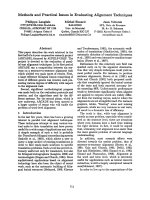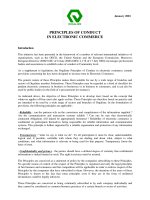Chapter 12: Economics, Global, and Other Issues in Electronic Commerce pptx
Bạn đang xem bản rút gọn của tài liệu. Xem và tải ngay bản đầy đủ của tài liệu tại đây (183 KB, 37 trang )
1
© Prentice Hall, 2000
Chapter 12
Economics, Global, and
Other Issues in
Electronic Commerce
2
© Prentice Hall, 2000
Learning Objectives
❚
Identify the major impacts of Web-based economics
❚
Describe the major components of Web-based
economics
❚
Analyze the impact of online markets on competition
❚
Describe the impacts and industry structure on
intermediation
❚
Describe the role and impact of virtual communities
❚
Evaluate the issues involved in global electronic
commerce
❚
Analyze the impact of EC on small businesses
❚
Understand the research opportunities in EC
❚
Describe the factors that will determine the future of
EC
3
© Prentice Hall, 2000
Marketplace V s. Marketspace
❚
Markets have three main functions
❙
Matching buyers and sellers
❙
Facilitating the exchange of information, goods,
services and payments
❙
Providing an institutional infrastructure
❚
Electronic Marketplaces = Marketspaces
❙
Increase effectiveness
❙
Lower distribution costs
❙
‘Friction-free’ markets
4
© Prentice Hall, 2000
Marketplace V s. Marketspace
(cont.)
❚
Regular and EC economics are completely
different
❙
EC involves gathering, selecting, synthesizing,
and distributing information
❙
Economics of EC starts with supply and
demand, and ends with pricing and
competition
5
© Prentice Hall, 2000
The Components of
Digital (Virtual) Economics
❚
Digital Products
Information and entertainment products that are digitized :
•
Paper-based documents : books, newspapers, magazines journals, newsletters
•
Product information : product specifications, catalogs, user manuals
•
Graphics : photographs, postcards, calendars, maps, posters, x-rays
•
Audio : music recordings, speeches, lectures, industrial voices
•
Software : programs, games, development tools
Symbols, tokens and concepts :
•
Tickets and reservations : airlines, hotels, concerts, sport events, transportation
•
Financial instruments : checks, electronic currencies, credit cards, securities
Processes and services :
•
Government services : forms, benefits, and welfare payments, licenses
•
Electronic messaging : letters, faxes, telephone calls
•
Business value creation processes : ordering, bookkeeping, inventorying
•
Auction, bidding, bartering
•
Remote education, telemedicine, and other interactive services
•
Cybercafes interactive entertainment, virtual communities
6
© Prentice Hall, 2000
❚
The Consumers— people worldwide that surf the Web are potential
buyers of goods and services
❚
The Sellers— frontstores available on the Net, advertising and/or
offering millions of items
❚
The Infrastructure Companies— companies provide the
hardware and software necessary to support EC
❚
The Intermediaries— intermediaries of all kinds offer their services
on the Web
❚
The Support Services— ranging from certification and trust, which
assures security to knowledge providers
❚
Content Creators— media-type companies create and perpetually
update Web pages and sites
The Components of
Digital (Virtual) Economics (c ont.)
7
© Prentice Hall, 2000
Competition in Electronic Commerce
❚
Impacts on competition
❙
Lower buyers’ search cost
❙
Speedy comparisons
❙
Differentiation
❙
Lower price
❙
Customer service
❙
Digital products lack normal wear and tear
8
© Prentice Hall, 2000
Competition in Electronic Commerce
(cont.)
❚
Perfect competition
❙
Enable many buyers and sellers to enter the market
at little or no cost (no barriers to entry)
❙
Not allow any buyers and sellers to individually
influence the market
❙
Make certain products homogeneous (no product
differentiation)
❙
Supply buyers and sellers with perfect information
about the products and the market participants and
conditions
9
© Prentice Hall, 2000
Competition in Electronic Commerce
(cont.)
❚
Observations regarding competitiveness
❙
There will be many new entrants
❙
The bargaining power of buyers is likely to increase
❙
There will be more substitute products and services
❙
The bargaining power of suppliers may decrease
❙
The number of industry competitors in one location
will increase
10
© Prentice Hall, 2000
Cost Curves
Quantity
Cost
per
unit
Optimal
Regular Products
Cost
per
unit
Quantity
Digital Products
11
© Prentice Hall, 2000
The Need for a Critical Mass of Buyers
❚
Reasons for the need for critical mass of buyers
❙
Fixed cost of EC is high, need many customers to cover it.
❙
Strong and fair competition can be developed
❚
Estimated Internet users worldwide :
❙
150-200 million range (1999)
❙
Small number as compared with an estimated 1.3 billion TVs
❚
No need to wait a few years before starting EC
❙
Look at the microlevel segmentation of the market you are
trying to reach
12
© Prentice Hall, 2000
Quality Uncertainty and Quality
Assurance
❚
Price is becoming the major factor influencing
many Web purchases
❚
Quality is extremely important in many situations
❚
Issue of quality is related to issue of trust
❚
Quality assurance by a trusted 3
rd
party is needed
❙
For example : Trust-e and Better Business Bureau (BBB)
13
© Prentice Hall, 2000
Quality Uncertainty and Quality
Assurance (con t.)
❚
Solutions for quality uncertainty
❙
Provide free samples
❘
clear signal that the vendor is confident about the quality
❙
Return if you are not satisfied
❘
providing a guarantee, or a full refund, for dissatisfied
customers is facilitating EC
❘
returns not feasible for digital products
•
many digital products such as information, knowledge, or
educational material, are fully consumed when they are viewed
by consumers
•
returning a product or refunding a purchase price may be
impractical due to transaction costs
14
© Prentice Hall, 2000
Pricing on the Internet
❚
Price Discovery
❙
Electronic marketplaces enable new types of price
discovery
❘
Web-based auctions at Onsale.com and eBay.com
❘
Intermediaries such as Priceline (www.priceline.com)
❘
Agents such as Kasbah (ecomerce.medis.mit.edu/kasbah)
The ability to
customize
products
The ability to
price
discriminate
15
© Prentice Hall, 2000
Online Vs. Offline Pricing
❚
How to price the online Vs. the offline products or
services
❘
Pacific Brokerage Services (www.tradepbs.com)
•
a discount broker
•
offered almost 50% commission discount for online services
❘
Banking Industry
•
most do not offer any discounts for going online
•
some even charge additional online fixed monthly service fee
•
some, whose strategy is to aggressively go online, provide discount
❘
Retailers
•
no clear strategy
16
© Prentice Hall, 2000
Contributors to Electronic Market
Success
❚
Product characteristics
❙
Digitizable products; low priced items; computers;
electronics, consumer products; and even cars
❚
Industry characteristics
❙
The need for a transaction broker exists (e.g.,
stocks)
❚
Seller characteristics
❙
In oligopolistic situations, sellers can maintain an
environment of lower volume, higher profit margin
transactions
❚
Consumer characteristics
❙
Patient and analytical consumers
17
© Prentice Hall, 2000
Impacts on Industry Structure
Seller 1
Seller 1
Seller 1
Customer
Product Distribution Network
Market Information
Exchange
Information
Product
Traditional Market Industry Structure
❚
Traditional market
❙
Customers search out information (about the
products available and their prices, quality, and
features) from a wide range of sources
18
© Prentice Hall, 2000
Impacts on Industry Structure (cont.)
❚
Electronic markets
❙
The search cost for consumers is reduced
❙
Consumers can buy products for lower prices,
intermediaries play new roles
Product Distribution Network
Seller 1
Seller 1
Seller 1
Customer
Electroni
c Market
Industry Structure with an Electronic Market
Information
Product
19
© Prentice Hall, 2000
The Roles and Value of Brokers in
Electronic Markets
❚
Search costs for finding partners—high
❚
Lack of privacy; can not remain anonymous
❚
Incomplete information; a broker can get
more
❚
Contracting risk of refusing to pay, poor
quality products, etc.
❚
Pricing inefficiencies, opportunities may be
missed
Limitations of Privately Negotiated Transactions
20
© Prentice Hall, 2000
Potential Winners and Losers in EC
❚
Proprietary network owners
❚
Midsize manufacturers
❚
Technology suppliers
❚
Market makers
❚
Online dedicated companies
❚
Conventional retailers that use online extensively
❚
Providers of diversified Internet services
❚
Advertisement and target marketing companies
❚
Security, special infrastructure, and payment systems providers
❚
Internet access providers
❚
Portal providers
❚
A few large resellers
❚
EC software companies
❚
Winners
21
© Prentice Hall, 2000
❚
Most wholesalers, especially small ones
❚
Brokers
❚
Salespeople
❚
Non-differentiated manufacturers
Potential Losers in EC
22
© Prentice Hall, 2000
Virtual Communities
❚
The Internet Communities
❙
Web is being transformed into a social Web of communities
❙
Types of communities
❘
Communities of transactions
•
facilitate buying and selling
❘
Communities of interest
•
place for people to interact with each other on a specific topic
❘
Communities of relations
•
be organized around certain life experiences
❘
Communities of fantasy
•
place for participants to create imaginary environments
23
© Prentice Hall, 2000
Virtual Communities (cont.)
❙
Ways to transform a community site into a
commerce site:
Understand a particular niche
industry, its information needs,
and the step-by-step process by
which it does the research
needed to do business.
Build a site that provides that
information, either through
partnerships with existing
publishers and information
providers or by gathering it
independently.
Set up the site to mirror the steps
a user goes through in the
information-gathering and
decision-making process.
Build a community that relies on
the site for decision support.
Start selling products and services, such as sample chips to engineers,
that fit into the decision-support process.
24
© Prentice Hall, 2000
Virtual Communities (cont.)
❚
The Expected Payback
❙
Customer loyalty increases
❙
Increased sales
❙
Customer participation and feedback
increases
❙
Increased repeat traffic to site
❙
Drive new traffic to the site
25
© Prentice Hall, 2000
Virtual Communities (cont.)
❚
Creating economic value
❙
Members input useful information in the form of
comments, feedback, elaborating their attitudes
and beliefs, and information needs of the
community
❙
The community brings together consumers of
specific demographic and interest
❙
Communities charge members content fees for
downloading certain articles, music, or pictures









